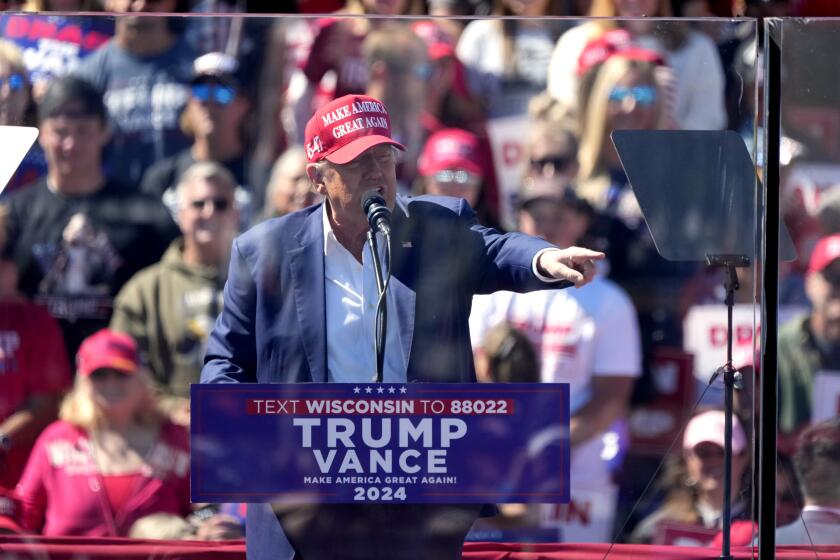The men who tamed the IRA
If history is a nightmare from which we are trying to awaken, as James Joyce said, then the people of Ireland finally woke up from troubled slumber Thursday.
The announcement that the Irish Republican Army was abandoning its more than 30 years of violence signaled an epochal event unlike any other in modern Irish history. British Prime Minister Tony Blair called it “a step of unparalleled magnitude; Irish Prime Minister Bertie Ahern called it “a momentous ... development.”
But the IRA did not lay down its arms on the spur of the moment. Rather, its statement was the result of decades of painstaking work by Gerry Adams and Martin McGuinness, the leaders of Sinn Fein, the political wing of the IRA. They took on one of the immutable forces in Irish life and changed it from within.
It’s been a delicate, often dangerous walk for Adams and McGuinness as they sought to win support for peace without moving too far ahead of their core constituency. There are many around the world who distrust Adams and see him as an unrepentant terrorist putting a moderate front on the IRA, while some partisans of the Republican cause believe that he has gone soft.
Under the circumstances, it is remarkable that Adams and McGuinness have accomplished as much as they have.
The name of the IRA has been writ large in Irish history for more than a century. It fought a war of independence, which was followed by the British partition of Ireland in 1921, which in turn was followed by another vicious civil war after an IRA split. Then, successive IRA campaigns to end the partition ensued.
In the latest burst of violence, which started in 1969, more than 3,600 lives were sacrificed as the consequences of partition came home to roost. The nightmare was in full flood.
Now, the IRA’s statement has changed everything. How Adams, the president of Sinn Fein, and McGuinness, his chief negotiator, succeeded in taking an armed revolutionary movement and placing it on a road to peaceful political activism is an extraordinary story.
Many times in the past, Irish leaders have tried and failed. Michael Collins, who in many ways created the IRA’s revolutionary tradition, lost his life attempting to turn it against violence during the civil war in 1922. Adams and McGuinness came of age four decades later, as young partisans of the Republican cause in the 1960s. But they recognized very early on that the war was not winnable, that the British army and the IRA had essentially fought each other to a standstill.
Imperceptibly at first, the two men began to change the fundamental premise on which the movement was based -- that an armed campaign was the only solution. In 1972, shortly after 23-year-old Adams was released from internment on a British prison ship (where he’d been held as a suspected IRA member), he and McGuinness convened a secret dialogue with an influential Northern Ireland politician, John Hume, then leader of the province’s major Roman Catholic party. They formulated what became the Hume-Adams document -- essentially a wish list for nationalists.
Adams and McGuinness approached the Irish and British governments in discussions based on that document, which argued for power-sharing and a greater involvement in Northern Ireland by the Irish government. After initial deep suspicion, both governments agreed to talk.
The first public indication that a new era was arriving came during the most inflammatory episode of recent Irish history, when 10 IRA men died during hunger strikes at the Maze prison in the early 1980s. On his deathbed, hunger-strike leader Bobby Sands was elected to the British Parliament. The incredible groundswell of support showed the political potential for the movement. The significance was something that Adams and McGuinness immediately grasped.
In the 1990s, another factor emerged. Irish American supporters of President Clinton convinced him that major change was stirring in Ireland and that the U.S. could help. Thus, a powerful outside force was brought to bear on the peace process.
Most vital, however, was the internal debate within Sinn Fein and the IRA. Adams worked slowly and deliberatively, never moving too far in front of the rank and file. Sometimes he had to perform tasks that won him harsh international criticism, such as carrying the coffin of an IRA bomber who had killed many innocent people. It was the price he had to pay to retain leadership over a group notoriously suspicious of politics.
By increments, the strategy began to work. The new peace policy led to significant electoral support. Soon a party that had started with less than 2% popular support became the second-largest party in Northern Ireland.
It was within that framework that Adams and McGuinness persuaded the IRA to carry out the 1994 cease-fire. A few years later the Good Friday agreement, including many of the original Hume-Adams proposals, was adopted. Adams now had a fair wind behind him. His colleagues saw him working the grass roots, being welcomed at the White House, meeting the British and Irish prime ministers.
In the end, he and McGuinness simply outworked, outthought and outmaneuvered their opponents, both internal and external. Sinn Fein’s spectacular election success, and the appointment of McGuinness as Northern Ireland’s education minister had a dramatic psychological effect on those citizens who had been locked out of power for so long.
The IRA decision to abandon its armed campaign was an inevitable outgrowth of the long-held plans of Adams and McGuinness. They had replaced the nightmare with a dream.
More to Read
Sign up for Essential California
The most important California stories and recommendations in your inbox every morning.
You may occasionally receive promotional content from the Los Angeles Times.










